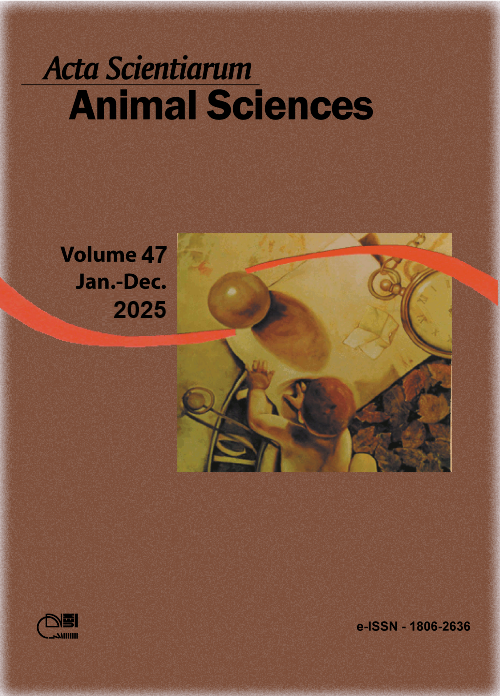Assessment of the effects of the BARF diet on the health of dogs
Resumo
The study aimed to evaluate the BARF (Biologically Appropriate Raw Food) diet based on the mixtures used and to check the impact of the diet on dogs' health by analyzing changes in blood parameters before and after the introduction of a raw diet. The primary research method for this work was an online survey made via the website www.docs.google.com/forms. One hundred questionnaires were obtained in the study. In addition, caregivers of dogs fed the BARF diet were asked to provide laboratory tests, of which 15 results of morphology, biochemistry and expanded ionogram of dogs were obtained before and after introducing the raw diet. The survey results were prepared in Excel and STATISTICA 13.3 (TIBCO Software). In contrast, the blood test results were compared using the Student's T-test for paired samples. Observations and conducted research showed that after introducing the BARF diet to their animals, the respondents noticed many positive effects of their diet. Some of the dogs tested improved their laboratory performance parameters.
Downloads
Referências
Ahmed, F., Cappai, M. G., Morrone, S., Cavallo, L., Berlinguer, F., Dessì, G., Tamponi, C., Scala, A., & Varcasia, A. (2021). Raw meat based diet (RMBD) for household pets as potential door opener to parasitic load of domestic and urban environment. Revival of understated zoonotic hazards? A review. One Health, 13, 100327. https://doi.org/10.1016/j.onehlt.2021.100327
Barteczko, J., Bielański, P., & Borowiec, F. (2020). Żywienie zwierząt i paszoznawstwo. Podstawy szczegółowego żywienia zwierząt. Wydawnictwo Naukowe PWN SA, Warszawa, 2(15), 471-495.
Bermingham, E. N., Maclean, P., Thomas, D. G., Cave, N. J., & Young, W. (2017). Key bacterial families (Clostridiaceae, Erysipelotrichaceae and Bacteroidaceae) are related to the digestion of protein and energy in dogs. Peer J, 5, 2-19. https://doi.org/10.7717/peerj.3019
Berschneider, H. M. (2002). Alternative diets. Clinical techniques in small animal practice, 17(1), 1-5. https://doi.org/10.1053/svms.2002.27782
Brozić, D., Mikulec, Z., Samardżija, M., Duricić, D., & Valpotić, H. (2019). Raw Meat-Based Diet (BARF) in Dogs and Cats Nutrition. Veterinary Journal of Republic of Srpska, 19(2), 313-321. https://doi.org/10.7251/VETJEN1902314B
Case, L. P. (2014). Logika psiego jedzenia. Jak rozsądnie wybrać karmę dla psa w erze nadmiaru możliwości?. Wydawnictwo COAPE Polska.
Cholewiak-Góralczyk, A. (2021). Psie smaki. o zbilansowanej diecie dla psów. Wydanie.
Davies, R. H., Lawes, J. R., & Wales, A. D. (2019). Raw diets for dogs and cats: a review, with particular reference to microbiological hazards. Journal of Small Animal Practice, 60(6), 329-339. https://doi.org/10.1111/jsap.13000
Freeman, L. M., Chandler, M. L., Hamper, B. A., & Weeth, L. P. (2013). Current knowledge about the risks and benefits of raw meat–based diets for dogs and cats. Journal of the American Veterinary Medical Association, 243(11), 1549-1558. https://doi.org/10.2460/javma.243.11.1549
Guidi, D. (2021). Żywienie i dietetyka psów i kotów. Przewodnik dla lekarza weterynarii. Edra Urban and Partner.
Hajek, V., Zablotski, Y., & Kölle, P. (2022). Computer-aided ration calculation (Diet Check Munich) versus blood profile in raw fed privately owned dogs. Journal of Animal Physiology and Animal Nutrition, 106(2), 345-354. https://doi.org/10.1111/jpn.13601
Kazimierska, K., Biel, W., & Witkowicz, R. (2020). Mineral Composition of Cereal and Cereal-Free Dry Dog Foods versus Nutritional Guidelines. Molecules, 25(21), 5173. https://doi.org/10.3390/molecules25215173
Köhler, B., Stengel, C., & Neiger, R. (2012). Dietary hyperthyroidism in dogs. Journal of Small Animal Practice, 53(3), 182-184. https://doi.org/10.1111/j.1748-5827.2011.01189.x
Kölle, P., & Schmidt, M. (2015). Raw-meat-based diets (RMBD) as a feeding principle for dogs. Tierärztliche Praxis Ausgabe K: Kleintiere / Heimtiere, 43(6), 409-419. https://doi.org/10.15654/TPK-150782
Simonsen, J. E., Faskeno, G. M., & Lillywhite, J. M. (2014). The Value-Added Dog Food Market: Do Dog Owners Prefer Natural or Organic Dog Foods? Journal of Agricultural Science, 6(6), 86. https://doi.org/10.5539/jas.v6n6p86
Sontas, B. H., Schwendenwein, I., & Schäfer-Somi, S. (2014). Primary anestrus due to dietary hyperthyroidism in a miniature pinscher bitch. Canadian Veterinary Journal, 55(8), 781-785.
Wu, Y., Fan, R., Wang, Y., Lei, L., Feßler, A. T., Wang, Z., Wu, C., Schwarz, S., & Wang, Y. (2019). Analysis of combined resistance to oxazolidinones and phenicols among bacteria from dogs fed with raw meat/vegetables and the respective food items. Scientific Reports, 9(1), 15500. https://doi.org/10.1038/s41598-019-51918-y
Zeugswetter, F. K, Vogelsinger, K., & Handl, S. (2013). Hyperthyroidism in dogs caused by consumption of thyroid-containing head meat. Schweizer Archiv für Tierheilkunde, 155, 149-152. https://doi.org/10.1024/0036-7281/a000432
Copyright (c) 2025 Maciej Bąkowski, Aleksandra Garbiec, Magda Miklaszewska

This work is licensed under a Creative Commons Attribution 4.0 International License.
DECLARAÇÃO DE ORIGINALIDADE E DIREITOS AUTORAIS
Declaro que o presente artigo é original, não tendo sido submetido à publicação em qualquer outro periódico nacional ou internacional, quer seja em parte ou em sua totalidade.
Os direitos autorais pertencem exclusivamente aos autores. Os direitos de licenciamento utilizados pelo periódico é a licença Creative Commons Attribution 4.0 (CC BY 4.0): são permitidos o compartilhamento (cópia e distribuição do material em qualqer meio ou formato) e adaptação (remix, transformação e criação de material a partir do conteúdo assim licenciado para quaisquer fins, inclusive comerciais.
Recomenda-se a leitura desse link para maiores informações sobre o tema: fornecimento de créditos e referências de forma correta, entre outros detalhes cruciais para uso adequado do material licenciado.








































